AMD Ryzen 7 8700G and Ryzen 5 8600G Review: Zen 4 APUs with RDNA3 Graphics
by Gavin Bonshor on January 29, 2024 9:00 AM EST- Posted in
- CPUs
- AMD
- APUs
- Phoenix
- 4nm
- Zen 4
- RDNA3
- AM5
- Ryzen 8000G
- Ryzen 7 8700G
- Ryzen 5 8600G
CPU Benchmark Performance: Rendering
Rendering tests, compared to others, are often a little more simple to digest and automate. All the tests put out some sort of score or time, usually in an obtainable way that makes it fairly easy to extract. These tests are some of the most strenuous in our list, due to the highly threaded nature of rendering and ray-tracing, and can draw a lot of power.
If a system is not properly configured to deal with the thermal requirements of the processor, the rendering benchmarks are where it would show most easily as the frequency drops over a sustained period of time. Most benchmarks, in this case, are re-run several times, and the key to this is having an appropriate idle/wait time between benchmarks to allow for temperatures to normalize from the last test.
Some of the notable rendering-focused benchmarks we've included for 2024 include the latest CineBench 2024 benchmark and an update to Blender 3.6 and V-Ray 5.0.2.
We are using DDR5-5200 memory as per the JEDEC specifications on the Ryzen 7 8700G and Ryzen 5 8600G, as well as DDR4-3200 on the Ryzen 7 5700G and Ryzen 5 5600G. The same methodology is also used for the AMD Ryzen 7000 series and Intel's 14th, 13th, and 12th Gen processors. Below are the settings we have used for each platform:
- DDR5-5200 CL44 - Ryzen 8000G
- DDR4-3200 CL22 - Ryzen 5000G
- DDR5-5600B CL46 - Intel 14th & 13th Gen
- DDR5-5200 CL44 - Ryzen 7000
- DDR5-4800 (B) CL40 - Intel 12th Gen
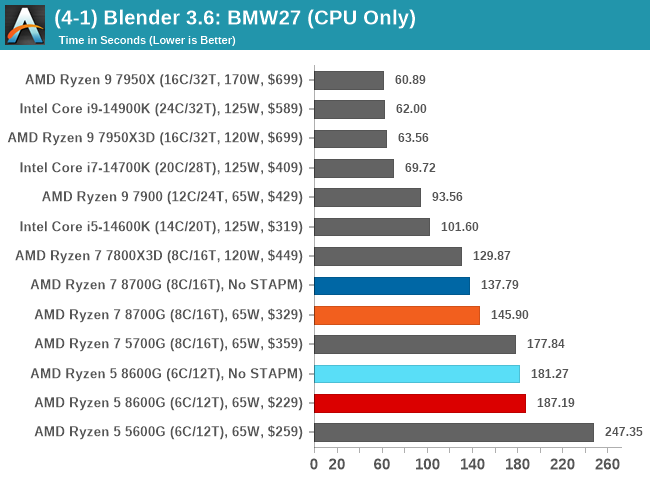
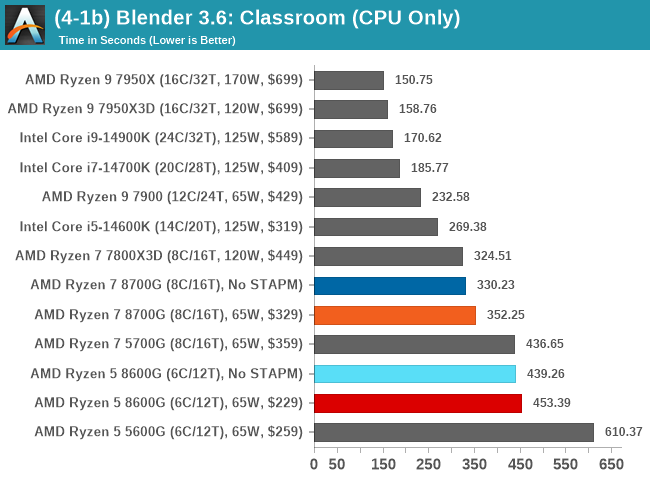
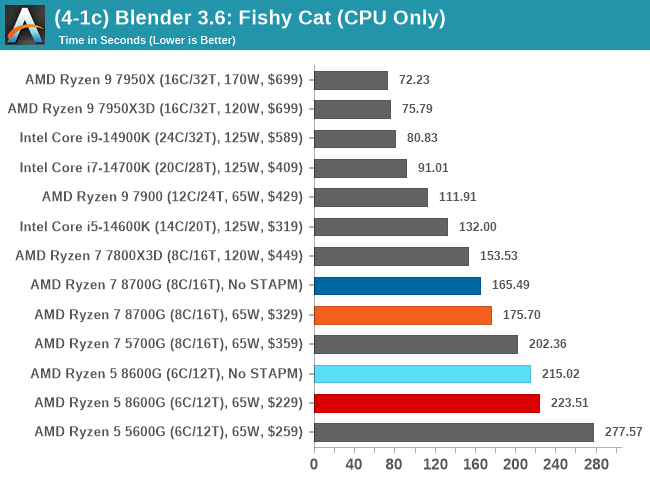
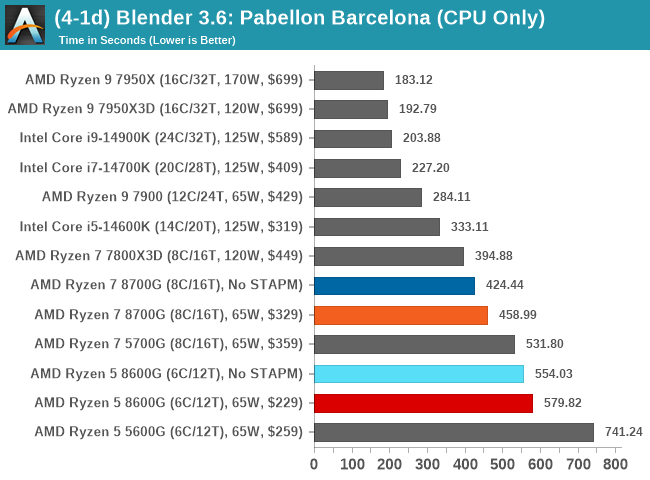

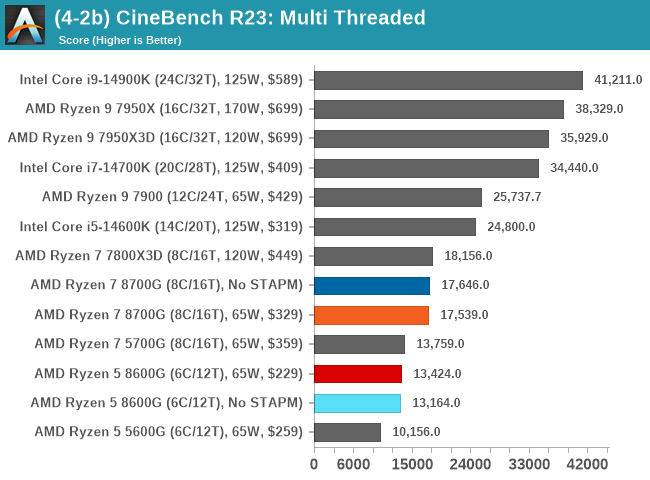
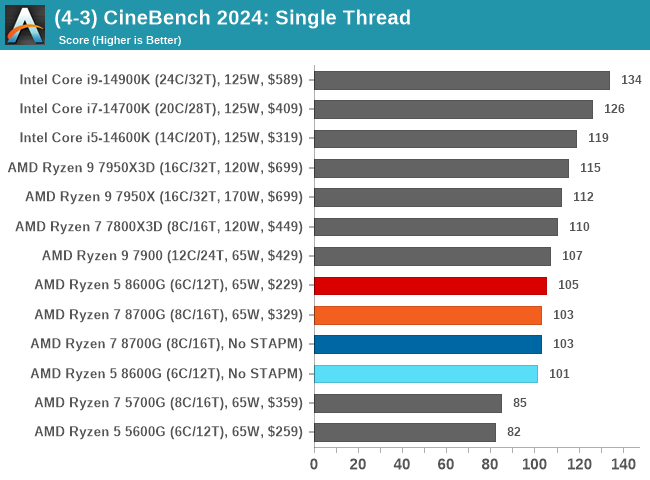
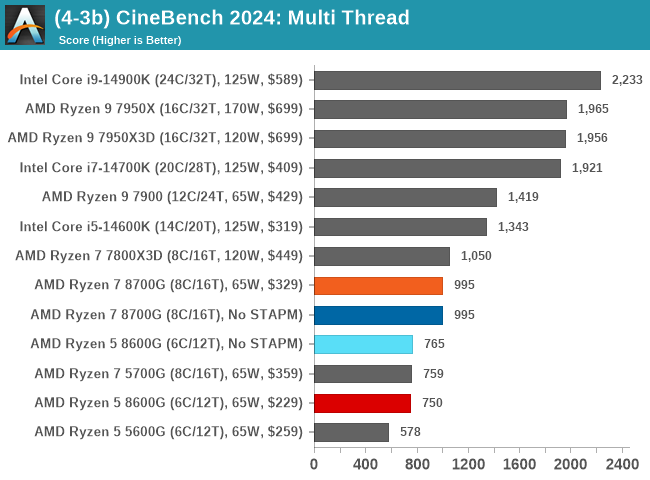

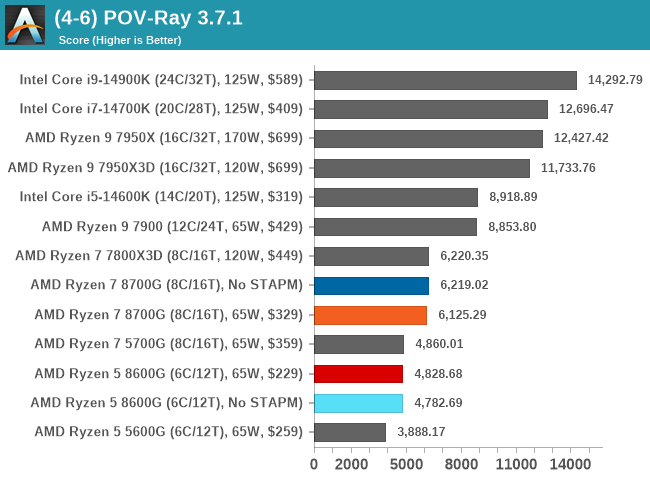
Another area where a mobile-based chip ported to a desktop doesn't quite match the bigger desktop chips is in rendering, a quintessential power and multi-threaded scenario where more cores and threads typically equate to higher performance. Both the Ryzen 7 8700G and Ryzen 5 8600G beat out the Ryzen 5000G series APUs, although the Ryzen 7 5700G consistently beats the Ryzen 5 8600G as we would expect from having two more cores with four more threads.
In our rendering tests without STAPM limitations, we saw notable gains in performance in Blender 3.6. The performance increase without sustained power loads being limited, we're seeing up to 7.5% better performance across the longer tests, with around 5% more performance in the shorter tests.










111 Comments
View All Comments
TheinsanegamerN - Tuesday, January 30, 2024 - link
guys WHY would you use a CPU only test in a CPU REVIEW??!?!?!?t.s - Tuesday, January 30, 2024 - link
Cause it have best iGPU in its class. If you won't test that, why bother testing, as it's almost certain that 7700x or 7700 will be better.AndrewJacksonZA - Tuesday, January 30, 2024 - link
👍TheinsanegamerN - Wednesday, January 31, 2024 - link
Ok, and in the CPU bench section they use a CPU test. How would you know if a 7700 would be better in CPU load if you dont test it?AndrewJacksonZA - Tuesday, January 30, 2024 - link
guys WHY would you only test PART of a CPU in a CPU REVIEW??!?!?!?TheinsanegamerN - Wednesday, January 31, 2024 - link
How DARE we want to see what a CPU does in a CPU review. WAAAH I NEED IGPU OR ILL CRY WAAAAHFWhitTrampoline - Tuesday, January 30, 2024 - link
Because AMD does not support ROCm/HIP for its iGPUs and its ROCm/HIP for consumer dGPUs is lacking as well on Linux. And the Blender Foundation starting with Blender 3.0/Later editions has dropped supporting OpenCL as the GPU compute API. And so since Blender 3.0/later the Blender Foundation only supports Nvidia's CUDA for non Apple PCs/Laptops and Apple's Metal for Apple silicon for Blender 3D 3.0/later editions.So without any Ryzen iGPU support for ROCm/HIP there's nothing to take the CUDA Intermediate Language Representation(ILR) and convert that to a form that can be executed on Radeon iGPU/dGPU hardware. And for Intel's iGPUs and dGPUs it's Intel's OneAPI/Level-0 that does the translating of the CUDA ILR to a form than can be executed on Intel's iGPU/dGPU hardware and for Intel that OneAPI/Level-0 works for Windows and Linux!
Blender 3D generates CUDA PTX ILR and All GPU Makers us Intermediate Languages for GPUs so GPU makers/others ship no pre-compiled binaries where software gets directly compiled into the GPUs Native Instruction Set in advance. And that's so the ILR code remains portable across OS/Ecosystems and GPU makers are free to modify their GPU ISA and still maintain comparability with software that only gets compiled into a portable Intermediate language Representation(ILR)
FWhitTrampoline - Tuesday, January 30, 2024 - link
Edit: maintain comparabilityto: maintain compatibility
I hate Firefox's Spell Checker its a Train Wreck as always!
thestryker - Monday, January 29, 2024 - link
Feels like these APUs deserve a DRAM scaling article comparing the IGP performance.GeoffreyA - Tuesday, January 30, 2024 - link
Yes, that would be a nice one. Always necessary for APUs.